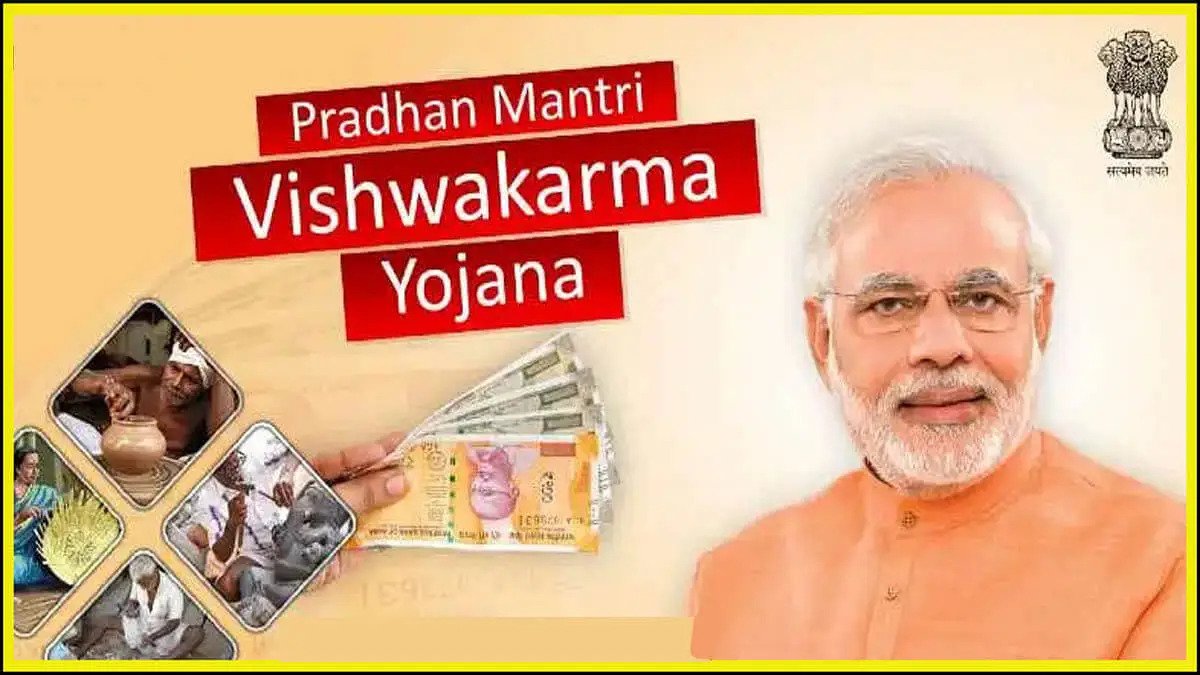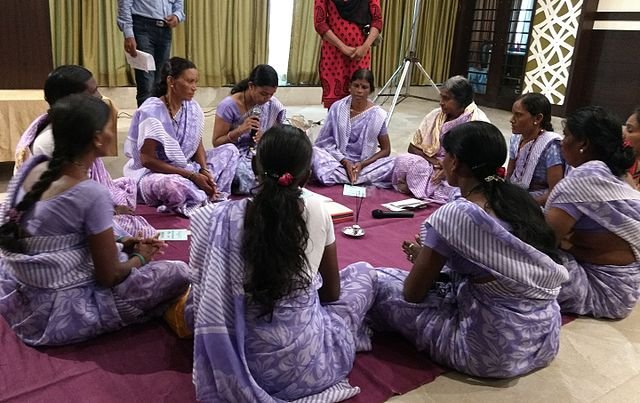
PM Vishwakarma Scheme
PM Vishwakarma, a Central Sector Scheme, was launched on 17th September, 2023 by the Prime Minister to provide end-to-end support to artisans and craftspeople who work with their hands and tools. The Scheme covers artisans and craftspeople engaged in 18 trades, viz.(i) Carpenter (Suthar/Badhai); (ii) Boat Maker; (iii) Armourer; (iv) Blacksmith (Lohar); (v) Hammer and Tool Kit Maker; (vi) Locksmith; (vii) Goldsmith (Sonar); (viii) Potter (Kumhaar); (ix) Sculptor (Moortikar, stone carver), Stone breaker; (x) Cobbler (Charmkar)/ Shoesmith/Footwear artisan; (xi) Mason (Rajmistri); (xii) Basket/Mat/Broom Maker/Coir Weaver; (xiii) Doll & Toy Maker (Traditional); (xiv) Barber (Naai); (xv) Garland maker (Malakaar); (xvi) Washerman (Dhobi); (xvii) Tailor (Darzi); and (xviii) Fishing Net Maker.
The Scheme envisages provisioning of the following benefits to the artisans and crafts persons:
(i) Recognition: Recognition of artisans and craftspeople through PM Vishwakarma certificate and ID card.
(ii) Skill Upgradation: Basic Training of 5-7 days and Advanced Training of 15 days or more, with a stipend of Rs. 500 per day;
(iii) Toolkit Incentive: A toolkit incentive of upto Rs. 15,000 in the form of e-vouchers at the beginning of Basic Skill Training.
(iv) Credit Support: Collateral free ‘Enterprise Development Loans’ of upto Rs. 3 lakh in two tranches of Rs. 1 lakh and Rs. 2 lakh with tenures of 18 months and 30 months, respectively, at a concessional rate of interest fixed at 5%, with Government of India subvention to the extent of 8%. Beneficiaries who have completed Basic Training will be eligible to avail the first tranche of credit support of upto Rs. 1 lakh. The second loan tranche will be available to beneficiaries who have availed the 1st tranche and maintained a standard loan account and have adopted digital transactions in their business or have undergone Advanced Training.
(v) Incentive for Digital Transaction: An amount of Re. 1 per digital transaction, upto maximum 100 transactions monthly will be credited to the beneficiary’s account for each digital pay-out or receipt.
(vi) Marketing Support: Marketing support will be provided to the artisans and craftspeople in the form of quality certification, branding, onboarding on e-commerce platforms such as GeM, advertising, publicity and other marketing activities to improve linkage to value chain.
In addition to the above-mentioned benefits, the Scheme will onboard the beneficiaries on Udyam Assist Platform as ‘entrepreneurs’ in the formal MSME ecosystem.
Enrolment of beneficiaries shall be done through Common Service Centres with Aadhaar-based biometric authentication on PM Vishwakarma portal. The enrolment of beneficiaries will be followed by a three-step verification which will include (i) Verification at Gram Panchayat/ ULB level, (ii) Vetting and Recommendation by the District Implementation Committee (iii) Approval by the Screening Committee.
For more information, the Guidelines of PM Vishwakarma can be accessed at pmvishwakarma.gov.in. For any queries, artisans and craftspeople may call at 18002677777 or email at pm-vishwakarma@dcmsme.gov.in.

Challenges Hindering the Growth of Self-Help Groups in Maharashtra
The self-help group (SHG) movement holds immense potential for empowering marginalized communities, fostering entrepreneurship, and promoting socio-economic development. However, in Maharashtra, this movement has faced significant challenges, impeding its growth and progress. In this article, we will explore the reasons behind the stagnant momentum of the SHG movement in Maharashtra.
The self-help group (SHG) movement has gained recognition as a powerful tool for empowering marginalized communities, fostering entrepreneurship, and enhancing socio-economic development. However, despite its success stories in various parts of India, the SHG movement in the state of Maharashtra seems to be grappling with a lack of momentum. This article aims to provide a comprehensive analysis of the reasons behind the stagnant growth of the SHG movement in Maharashtra, supported by data and statistics.
One of the primary reasons for the slow progress of the SHG movement in Maharashtra is the lack of sufficient support from the government. Although the government has implemented poverty alleviation programs, the focus on SHGs and their development remains limited. The data from the National Rural Livelihoods Mission (NRLM) reveals that Maharashtra accounted for only 4.5% of the total SHGs formed in the country, indicating a lack of robust government initiatives.
The SHG movement in Maharashtra faces challenges in terms of limited reach and accessibility, particularly in rural areas. The state’s diverse topography and scattered rural population make it difficult to establish and sustain SHGs in remote regions. The Census of India 2011 data highlights Maharashtra’s rural population of approximately 61.5 million spread across 43,000 villages, posing logistical challenges for SHG establishment and support.
Cultural and socioeconomic factors also contribute to the slow growth of the SHG movement in Maharashtra. The prevalence of caste-based hierarchies, gender inequalities, and conservative mindsets hinder the mobilization and active participation of communities in SHGs. The National Sample Survey Office (NSSO) data indicates that only 13% of rural women in Maharashtra were engaged in self-employment activities in 2019-20, reflecting limited female participation in SHGs.
Limited access to formal financial institutions hampers the growth of SHGs in Maharashtra. Reserve Bank of India (RBI) data reveals a low penetration of bank branches in rural areas, with only 26 branches per 100,000 adults. This lack of financial infrastructure limits SHGs’ access to credit, savings, and other financial services required for their sustainability and expansion.
Inadequate training and capacity building further impede the growth of SHGs in Maharashtra. A study by the Tata Institute of Social Sciences (TISS) highlights that only 32% of SHGs in Maharashtra received training on bookkeeping and accounting. Moreover, limited exposure to market linkages and insufficient knowledge about government schemes and policies hinder the development of SHGs in the state.
Effective institutional support and networking are crucial for the success of SHGs. However, Maharashtra lacks a robust support system for SHGs. The absence of strong federations and limited collaboration with non-governmental organizations (NGOs) hinder the growth and sustainability of SHGs. According to the NRLM, only 12% of SHGs in Maharashtra were federated as of 2021, underscoring the need for strengthening institutional support.
Conclusion
The self-help group (SHG) movement has the potential to transform the lives of marginalized communities and drive socio-economic development in Maharashtra. However, the lack of government support, limited reach and accessibility, cultural and socioeconomic factors, financial inclusion, inadequate training and capacity building, and weak institutional support and networking all contribute to the stagnant growth of the SHG movement in the state. To overcome these challenges, concerted efforts are required from the government, NGOs, and other stakeholders to address the issues, provide financial and technical support, and create an enabling environment for the sustainable growth of SHGs in Maharashtra. Only through such collective actions can Maharashtra unlock the full potential of the SHG movement and drive inclusive development throughout the state.
